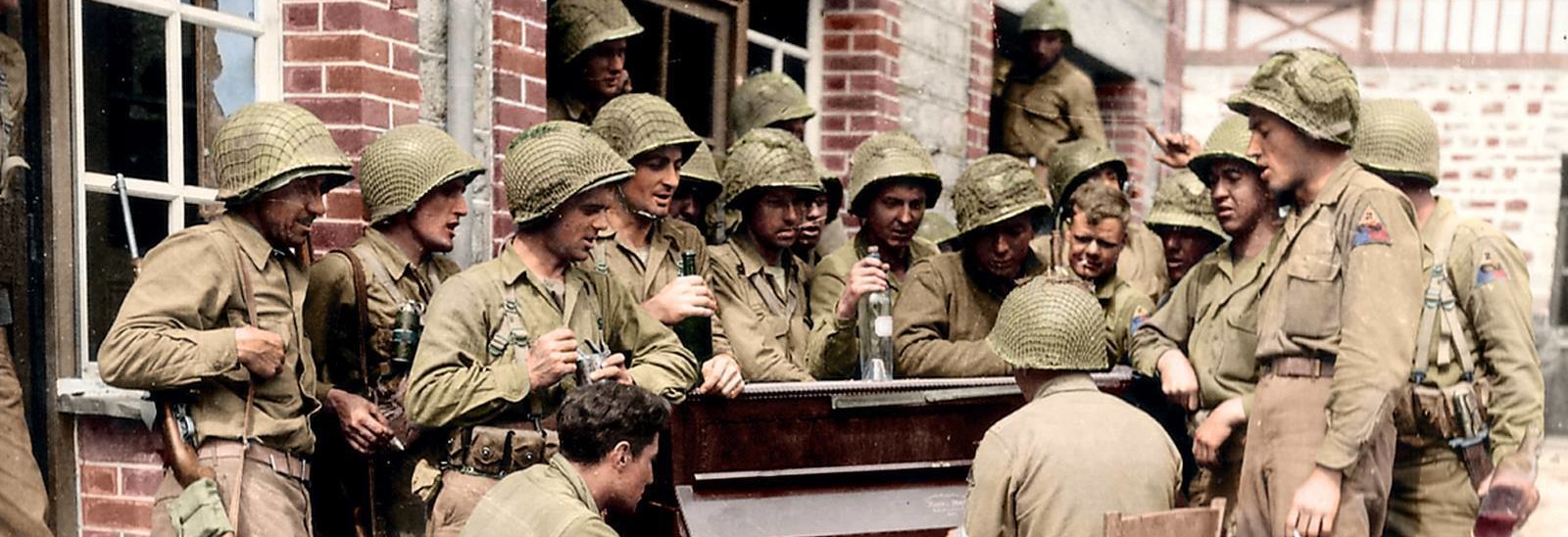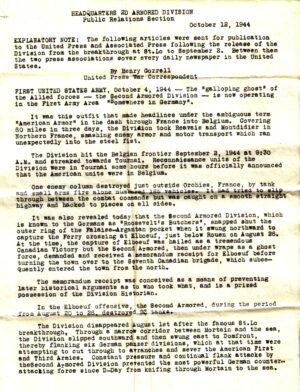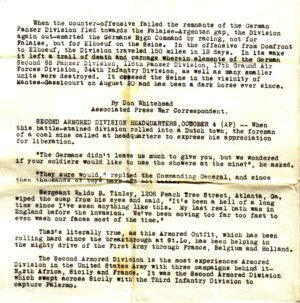Relevant after action reports units containing information
about the 17th Armored Engineer Battalion
Under construction
Headquarters 2nd armored division
public relations sections
12th October 1944
EXPLANATORY NOTE:
The following articles were sent for publication to the United States by the United press and associated Press following the release of The Division from the breakthrough at St. Lo to September 2. Between them the two press associations cover every daily newspapers in the United States.
By Henry Gerrell
United cross war correspondentFIRST UNITED STATES ARMY, October 4, 1944 – “the galloping ghost” of the allied forces – The second armored division — is now operating in the first army area “somewhere in Germany.”
It was this outfit that made headlines under the ambiguous term “American Armor” in the dash through France intro Belgium. Covering 60 miles in three days, the Division took Reavais and Montdidier in Northern France, smashing enemy armor and motor transport which ran unexpectedly into steel fist.
The division hit the Belgian frontier September 2, 1944, at 9:30 a.m. and streaked toward Tournai. Reconnaissance units of the Division were in Tournai some hours before it was officially announced that American units were in Belgium.
On enemy column destroyed just outside Orchies, France, by tank and small arms fire alone numbered 165 vehicles. It has tried to slip through between combat command but was caught on a smooth straight highway and hacked to pieces on all sides.
It was also revealed today that the Second Armored Division, which is known to the Germans as “Roosevelt’s Butchers”, snapped shut the outer ring of the Falaise-Argenten pocket when it swung northward to capture the Ferry Crossing at Elboeuf, just below Rouen, on august 26. At the time, the capture of Elboeuf was hailed as a tremendous Canadian victory but the Second Armored then under wraps as a ghost force, demanded and received a memorandum receipt for Elboeuf before turning the town over to the Seventh Canadian brigade, which subsequently entered the town from north.
The memorandum receipt was conceived as a means of preventing later historical arguments as to who took what, and is a prized possession of the Division Hostorian.
In the Elboeuf offensive, the second Armored, during the period from August 20 to 26, destroyed 93 tanks.
The division disappeared August 1 after the famous St. Lo breakthrough. Through a narrow corridor between Mortain and the sea, the Division slipped southward and then swung east to Domfront, thereby flanking six German panzer divisions, which at that time were attempting to cut through to Avranches and sever the American First and Third armies. Constant pressure and continual flank attacks by the second Armored Division prevented the most powerful German counter-attacking force since D-Day from knifing through Mortain to the sea.
When the counter-offensive failed the remnants of the German Panzer Divisions fled toward the Falaise-Argentan gap, the Division again outsmarted the German High Command by racing, not for Falaise, but for Elboeuf ont the Seine. In the offensive from Domfront to Elboeuf, the Division traveled 150 miles in 12 days. In its wake it left a trail of death and carnage wherein elements of the German Second SS Panzer Division, 116th Panzer Division, 17th Ground Air Forces Division, 344th infantry Division, as well as many smaller units were destroyed. It crossed the Seine in the vicinity of Mantes-Gassicourt on August 20 and has been dark horse ever since.
By Don Whitehead
Associated Press War Correspondent
SECOND ARMORED DIVISION HEADQUARTERS, OCOTOBER 4 (AP) – When this battle stained division rolled in a Dutch town, the foreman of a coalmine called at headquarters to express his appreciation for liberation.
“The Germans didn’t leave us much to give you, but we wondered of your soldiers would like to use the showers of the mine?”, he asked. “They sure would,” replied the Commanding General, and since then thousands of boys have had hot baths.
Sergeant Waldo B. Tinloy, 1206 Peach Tree Street, Atlanta, Georgia, wiped the soap from his eyes and said, “It’s been a hell of a long time since I’ve seen anything like this. My last real bath was in England before the invasion. We’ve been moving too far too fast to even wash our faces most of the time”.
That’s literally true, as this Armored Outfit, which has been rolling hard since the breakthrough at St. Lo, has been helping in the mighty drive of the First Army through France, Belgium and Holland.
The second Armored Division is the most experienced Armored Division in the United States Army with three campaigns behind it – North Africa, Sicily and France. It was the Second Armored Division which swept across Sicily with the Third Infantry Division to capture Palermo.


